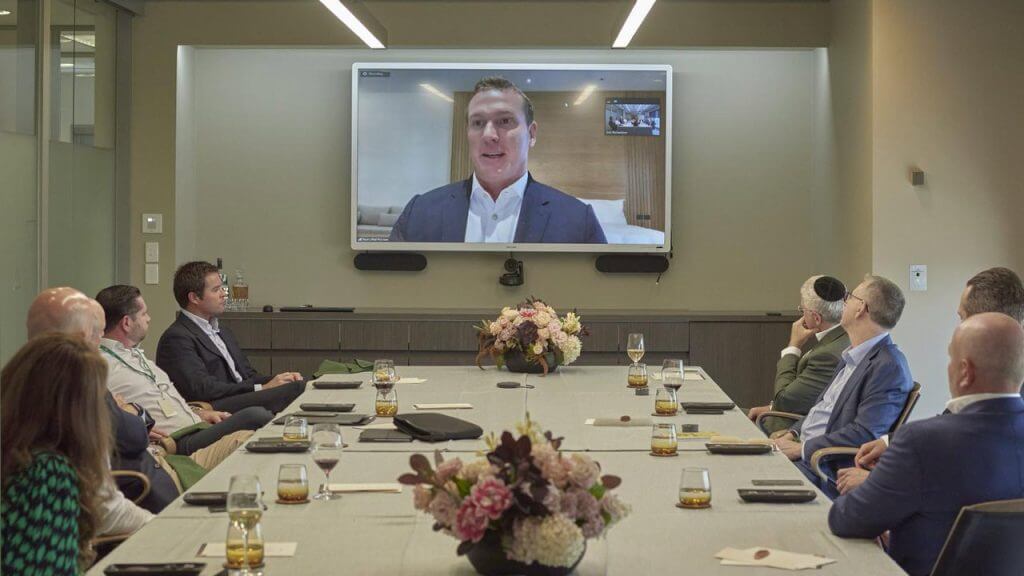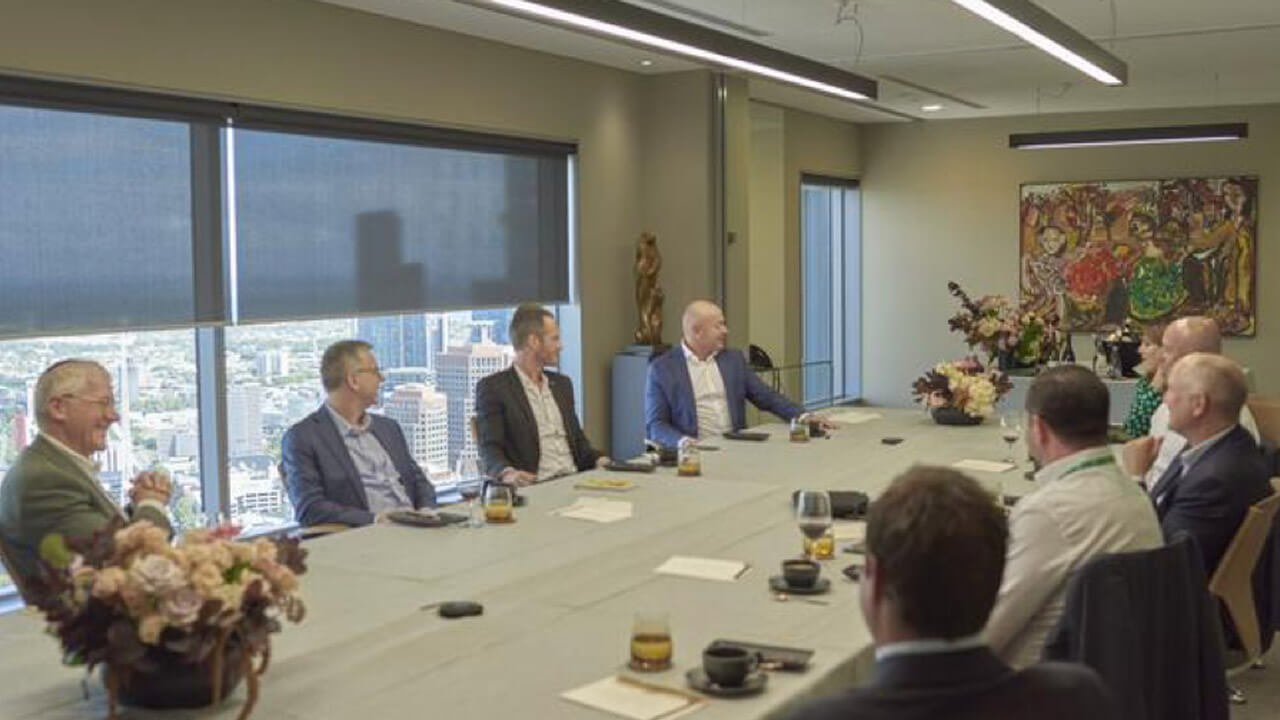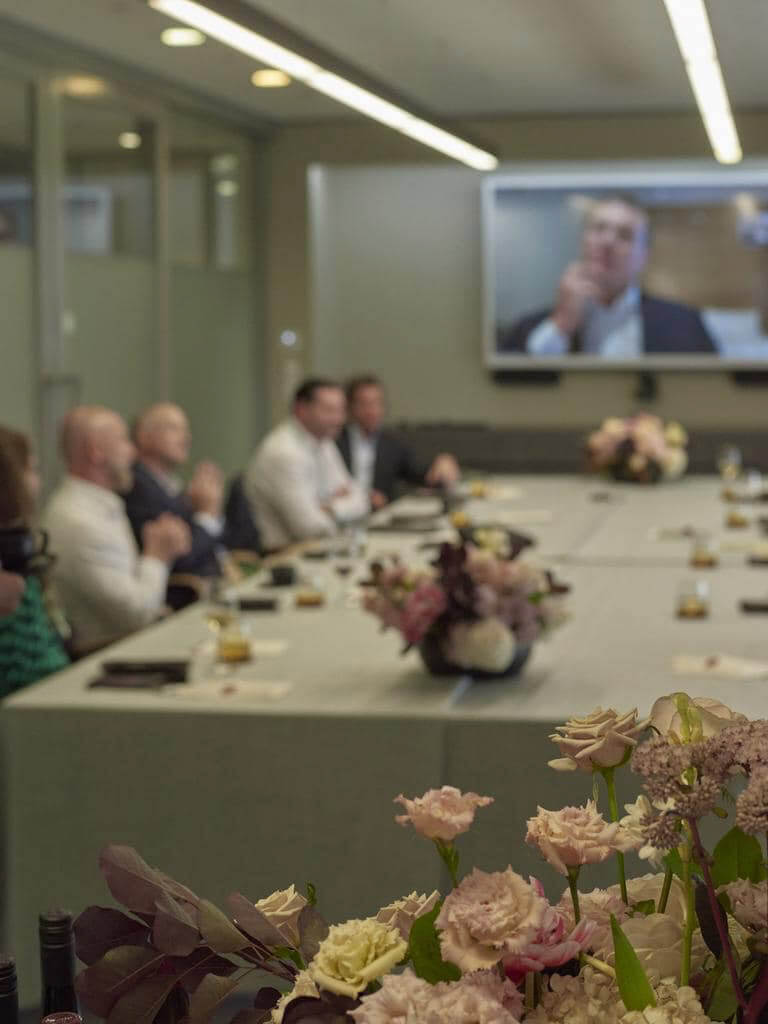Some of the country’s biggest property developers give a snapshot of the market now and what should be hot or not as the nation recovers from COVID-19.

The List property round table lunch, with Paul Blackburne on the screen, at Wingate offices in Melbourne. Picture: Josh Robenstone
Property has been one of the hottest sectors of the economy, but the COVID-19 pandemic changed the industry in many ways. Demand for apartments fell, regional property surged. Industrial warehouses were in vogue, shopping centres out of fashion. Some of the most prominent property developers in the country joined Damon Kitney and John Stensholt at a special roundtable hosted by wealth and advisory house Wingate and its founder and managing director Farrel Meltzer, to look at market now and give their views on what should be hot or not in the wake of COVID-19.
THE PANEL
- Paul Blackburne, Blackburne Property Group
- Sam Tarascio, Salta Properties
- Adelene Teh, Beulah International
- Will Deague, Deague Group
- Tim Gurner
- Nick Georgalis, Geocon
- Mark Harrison, Wingate
What happened in your part of the market in the past year?
Paul Blackburne: Sales did stop dead [here in Perth], but then pretty much as soon as we opened the displays again in May, June, July it got going again. It was tougher, a lot of people were cautious, but the sales were still going strong. Inquiry rates were huge, because people were at home online… looking around on REA and whatever. In October, we launched a $350 million [project] and that’s just hit about $250 million in sales. It’ll keep selling a million or two a day until it’s sold out.
Sam Tarascio: I’ll start from the one that’s the best, which is industrial. For all the reasons we know, that movement from traditional retail to logistics-style or multi-channel retailing [is really benefiting] logistics properties. Lack of land supply in Melbourne is really pushing up land values. We’re still, from a rental point of view, a lot cheaper n Melbourne than anywhere else so there’s still a really big attraction to Melbourne industrial.
Adelene Teh: We have just commenced construction on our seventh project in recent years, which in itself is a significant milestone and demonstrates our resilience as a company. We have also recently completed and settled two projects within the past six months, and will complete our first [Melbourne] CBD tower (which is also home to Australia’s first elevated indoor forest) in just a few weeks’ time. Alongside our residential projects, we are also working on our largest and most ambitious project to date, Southbank by Beulah. Once complete it will take out the title of Australia’s tallest tower and the tallest vertical garden in the world. We are currently in discussion with top global hotel operators, world-class retailers and art institutions.
Will Deague: If there was ever a year for our company to go into this situation, it was last year. We were finishing an office building in South Melbourne, which is low rise. All nice and COVID friendly. That finished in November. But for the first time ever we haven’t got a crane in the sky, we’re not building anything. We’ve shed some staff, consolidated a little bit. We’ve got 750 blocks of land in [outer suburban] Craigieburn to start on later this year.
It does seem for residential property there are some strong and weak parts of the market. What are you seeing from home or apartment buyers?
Tim Gurner: [Detached] houses are going to absolutely fly this year, there’s no question. I think they’ll be up 15 to 20 per cent, as a minimum. And then what we call our ‘ultra-luxury’ or high end stuff is going extremely well. So anything boutique, anything with a purpose to live in, I think it’s going to go very well. If there’s a desire and a need to move in quickly, there is pretty good demand. I think the big difference we’re seeing is the investment apartment [segment], the 300 apartments [in an inner-city project] stuff. I mean, you’d be kidding yourself to try to get something off the ground today. Almost impossible.
What does that mean for apartment investors then? And what are you seeing in the rents they can charge given there are fewer students coming to Australia and less immigration?
Tarascio: We have a huge oversupply of apartments available to rent [and] rents have gone down. Now we hear, I hear, in the media 10 per cent. I think … it’s more like 30 per cent, 40 per cent in some cases. And that’s because there are a lot of apartments that were built in the last sort of wave. We had a view that a correction was coming and a peak of delivery in 2021. And that by 2022 we were sort of back to an undersupply. That might have moved out a little bit now, now that COVID has given us a bit of a reprieve. But I think that by 2023 – and these dates are a little bit fluid – that we’ll have an even worse undersupply, because you’re not going to get projects off the ground.

The List property round table lunch held at Wingate offices in Melbourne. Picture: Josh Robenstone
What has changed as a result of COVID in terms of people moving city or state?
Nick Georgalis: [In Canberra] we usually only ever had about 2 per cent of our sales come out of Victoria, but last year that increased about 10 or 15 per cent. So we noticed specifically more interest coming out of the marketplace. The population growth is still there. About two years ago, we were probably doing 70 per cent owner occupied, 30 per cent investors. That’s taken a shift to be 50/50. And in fact our vacancy rate is under 1 per cent at the moment. And I think we just came up with the highest rents in housing and apartments in Australia as well.
Blackburne: We have had about 10 per cent [from the Eastern states] from more savvy investors picking the low of the market and trying to invest. They want to stay invested within Australia. But they feel obviously markets go through cycles, and they feel that their markets are in a downward phase of the cycle and that they want to find where the next upswing is.
Georgalis: Same with international purchases. We always sat around that 10 or 12 per cent. We went up to 20 per cent last year. So we did see that increase.

That demand from international buyers sounds interesting. Are there any other examples?
Mark Harrison: We’ve got a shopping centre on the market [in Byron Bay], and JLL [agents Jones Lang La Salle] told us … they’ve got more people in the data room for a week than they’ve ever had on any campaign they’ve run. And they’ve prepared an international marketing campaign around [Chris] Hemsworth and Zac Efron and these people that are coming to Byron now because it’s become an international, iconic destination, which is interesting.
Teh: Most projects we deliver are designed with downsizers and owner occupiers in mind and we’ve been fortunate that our projects have been protected from any major impacts. However these impacts are short term, and once the borders open we expect the property market to rebound substantially as a result of increased migration. Australia has shown great resilience throughout the pandemic and this will be attractive to people who are looking to move. By the time Southbank by Beulah is delivered in five years’ time, we believe Melbourne will have regained its title as one of the most liveable cities in the world.
Hotels is a sector that needs travellers, be it corporates travelling interstate or visitors coming from overseas. What is happening in that part of the market?
Georgalis: We’ve got two types of hotels: An Abode hotel that appeals to the blue collar workforce, and a five-star hotel for the white collar workforce. Our Abode hotels are only 10 per cent down EBITDA [earnings before interest, tax, depreciation and amortisation] last year. The five-star hotel is probably down 60 per cent EBITDA, which is still a lot better than the rest of Australia. We are in fact taking a hotel to market now, so it’ll be an interesting dynamic to see how that fares in the current climate.
Let’s turn our attention to offices. There’s been a lot of pessimism about the future of the office with so many people working from home in the past year. What is your forecast?
Tarascio: We think the future of offices is fairly bright, particularly non-CBD offices. They’re a bit more COVID safe, they’re lower to the ground, there’s less density. I think there’s going to be a bit of a focus towards non-CBD, and we have seen a bit of that across our portfolio. Another area where the risk is probably elevated a bit more is that lease terms are typically shorter, because clients are looking for more flexibility. But that said, we’re very optimistic.
Deague: We’re certainly not looking at any more office [projects]. Definitely not a hotel. Unless migration picks up we’re not going to do apartments. We’ll do some townhouses and house and land. But I guess half of our business at the moment is money lending, whether it’s through Wingate, direct or others. I went in very negative in March/April last year and I was running cash flows for the most dire situation in the world, and that’s the way it was looking. And then, I think the Australian government has done an incredible job with all the stimulus. And if we can get through … with unemployment intact and then a bit more confidence going, Australia is the place in the world where everyone’s going to want to live.
There are still issues for investors of apartments surely, particularly with what you’ve said about how difficult it will be for projects to get started in the next year or two?
Gurner: I think a big risk at the moment is that mum and dad investors will be pushed out by build-to-rent [projects by big international firms such as Blackstone]. If mum and dad don’t get back within two or three years they’ll just be wiped out, because obviously I’ve entered build to rent and if we get three years without competition we will take a big chunk of the market. So I think it’s a dangerous tipping point now, and I don’t think that’s healthy, by the way. I think mum and dad should be able to compete and need to be able to buy what we’ve all been building for the past 15 years. I think it’s really important that if they don’t do something about off-the-plan [projects being more attractive, then] build to rent will just take the entire rental market and I think we’ll turn to an American [condominium] mode versus build to rent atmosphere.
What needs to change to get the mum and dad investors back?
Gurner: Immigration has to come – I mean students have to come back. But I just don’t think anyone could tell you where we’re going to be at the end of this year. I think we’ve got to see what happens with JobKeeper. We got to see when people can actually come back. I think the Reserve Bank coming out saying we won’t move rates for four years. There is no question that that brought confidence to the market. Is that realistic though, if inflation gets cracking in the next 18 months? What happens? So we’re taking advantage of it in the sense that we’re going to build a massive book that we can do – whenever it is; like I don’t know if it’s next year or the year after or the year after that, but it doesn’t worry me too much. I think we are very confident on the long term fundamentals. What happens in the next two years, I honestly don’t know.
Tarascio: [Introducing] foreign buyers levies was about keeping the foreigners out to make room for the locals. The government didn’t realise that the foreigners were underpinning the start of projects to get your finance and get under way. So the stock they were thinking they would create by keeping foreigners out… it actually got rid of the stock that was being created for locals. We’ve gone backwards.
What did dealing with COVID teach you?
Gurner: I actually really enjoyed it. We were able to take stock, plan and strategise. We were growing fast but we didn’t have enough strategy behind it. Three months at home, in between Zoom calls, allowed me to take stock. For me it was amazing, it was the best thing that could have happened. Would I want it to happen again? Absolutely not; March and April were pretty negative. But I thought, we can’t sit here sooking. We knuckled down, worked harder than we’ve ever worked, and set ourselves up for the next 10 years. There is no way I could have done that sitting in 15 meetings a day. Time to think and plan, and time with family, was key. Also we are just residential. The diversified players did really well last year, so there was also a lesson in diversification.
Teh: Nothing beats in-person interaction for culture building, creativity and collaboration. We can be more efficient at home for certain tasks but not everything; sometimes we just need to come together to brainstorm and bounce ideas around. There is a lot of value in in-person meetings that virtual meetings cannot replace, so I don’t see these becoming obsolete as they are great for connecting on a more personal level and for creative workshops. This helps create an innovative workplace culture.
Georgalis: It was the realisation that I was pleased to be back in Canberra. I had control geographically – could touch, see and feel things. Being just in Canberra gave us perspective and allowed us to grow the pipeline. Yes we trimmed staff and costs at the edges, but the realisation that Canberra is our market, that we ride the wave there, either up or down, was really important for me.
Tarascio: It reaffirmed the strategy we have adopted for the past 50 years that you really need to think long term in property. And no knee-jerk reactions. You will be the first to go broke in property if you try to pick the top or the bottom; you will always get it wrong. Unless you have some sort of supernatural power, you will never be able to time your entry and exit point. For us, just our strategy of diversification across the sectors was key. We can pivot from industrial to commercial and retail, with some hotels in between.
Deague: Diversity is a key theme. We were way overweight with hotels two years ago and it would have been a far different scenario if we still had all the hotels. Tightening the disciplines across the company, which included shedding a few staff, was important. But it taught me to up the customer service a bit more. Sitting there with 50,000 [square metres] of office space in South Melbourne, we sat down and asked, ‘How are we going to hold these tenants.’ We thought about ways to keep them long term. And the biggest thing for me out of COVID was, how good is Australia? You look at the rest of the world but how good are we now? We get one [COVID] case a day and it is alarm bells.
Blackburne: I was brought up with a conservative perspective. Keep debt low, be conservative. We never buy land with debt, we never use external equity. It always stayed in the back of my mind. So I think these events are great. Strong businesses get stronger, and it does wipe out firms that aren’t delivering value or are over- leveraged. That is a good thing for the economy and the market. To ensure that product that doesn’t deliver quality to the end buyer generally disappears from the market. COVID re-integrated our core values that these things are going to happen every five to 10 years. If it wasn’t a pandemic it would have been something else.
